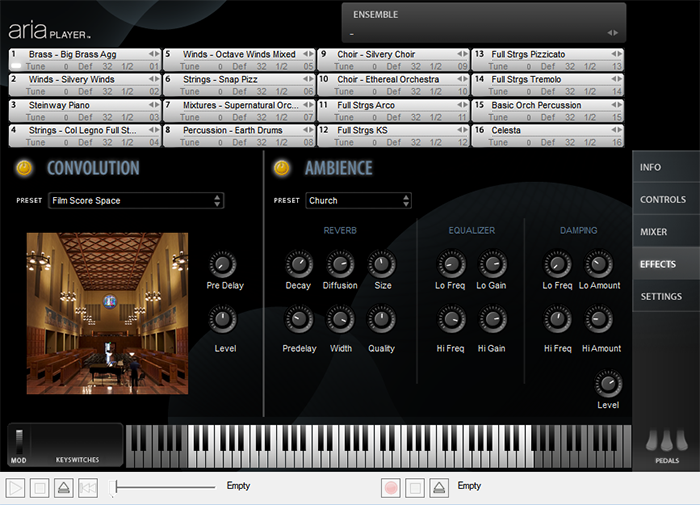
As musicians, we hear the word “reverb” bounced around often. We clap in auditoriums and amphitheaters to test for the ideal acoustic performance environment, but what exactly are we listening for?
Reverberation is the prolongation of sound, created by reflecting sound waves. In an electronic environment, we simulate how sounds reflect in an acoustical space using performance settings.
There are two primary options to apply reverb in the ARIA Player: Convolution and Ambience. In the screenshot above you can see what these settings look like in the Effects view in the ARIA Player.
Let’s clarify the difference between these two options:
- Convolution simulates acoustic environments using actual recorded samples of performance spaces.
- Ambience simulates the reflections of a performance space, much like a synthesizer can be used to simulate musical instruments.
There are adjustments within both Convolution and Ambience that can be set to fine-tune your sounds:

Not familiar with all these terms? Here are some brief descriptions:
- Decay: Controls the time it takes for the reverb to fade to silence.
- Diffusion: Adjusts the reflecting surfaces’ ability to spread out the reverb. This control has a subtle effect and is more noticeable in smaller rooms.
- Size: Refers to the size of the room. For best results, avoid putting a long delay in a small room.
- Predelay: Determines the amount of time between the instrument sound and the first reverb reflections.
- Width: Controls the stereo spread. Mono is 0% and full stereo glory is 100%.
- Quality: Controls the sonic clarity of the reverb, but uses more CPU resources.
Note that there are also Equalizer settings (bass and treble controls) and Damping, which controls how the Equalizer settings change as the instrument sound decays.
It’s not uncommon for us to hear from a customer who has adjusted these effects, but can’t hear any difference. When that happens we direct them to the Mixer view:

At first glance any mixer can be a little intimidating, but it’s really just a few controls duplicated for every channel in the mixer (in this case 16 times). Once you figure out what the few controls do in one channel, you’re good to go. Note that both the instrument and the mixer controls have corresponding numbers.
Above the vertical box highlights channel 1’s mixer controls:
- The Send knob determines the level of unaffected signal that gets sent to the reverb. My rule of thumb is to use less reverb on bass instruments, as they can become muddy. Instruments in the higher frequency range will do better with more reverb.
- The Pan knob places each instrument in the stereo field. Turn it hard left and it will only sound from the left speaker; straight up and the instrument will sound directly in front of you. Panning not only allows you to simulate where instruments are placed in your performance space, but also provides a way to find a sonic “place” for each instrument, making each one intelligible (equalization is another great way to do this, too).
I hope that this introduction to the ARIA reverb gives you enough information to experiment more freely with your music. Your ears are the best judge of what is right or wrong for you in any situation, so by all means explore different settings, and have fun!
 Michelle Jones is thrilled to join the MakeMusic Customer Success team. A recent graduate from the University of Colorado at Boulder, Michelle received dual B.A. in music performance (bassoon) and music education.
Michelle Jones is thrilled to join the MakeMusic Customer Success team. A recent graduate from the University of Colorado at Boulder, Michelle received dual B.A. in music performance (bassoon) and music education.
Michelle enjoys performing and hearing all kinds of music, and is particularly fond of Broadway musicals and Colorado Symphony Orchestra performances. She has taught elementary and middle school band, choir, and general music in the Denver Metro Area since moving here from Northern California.





